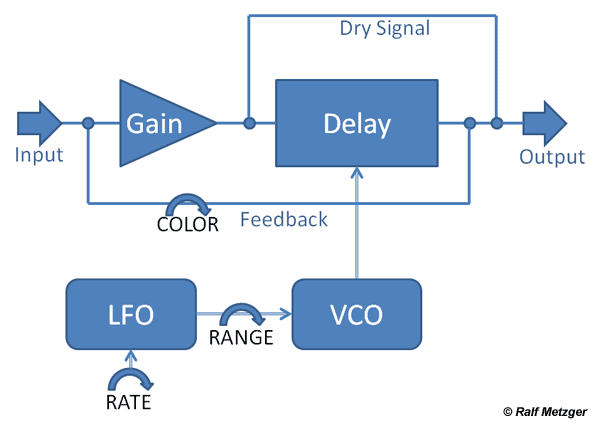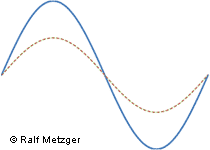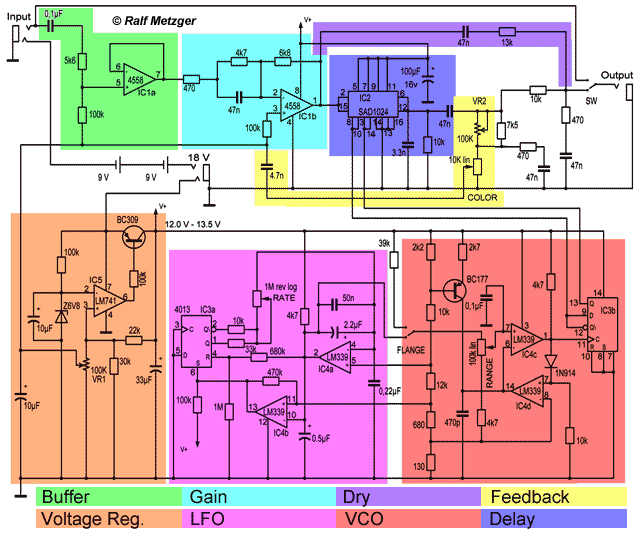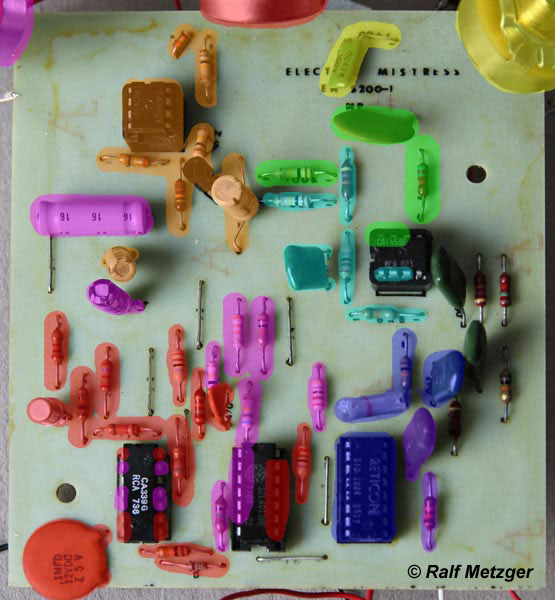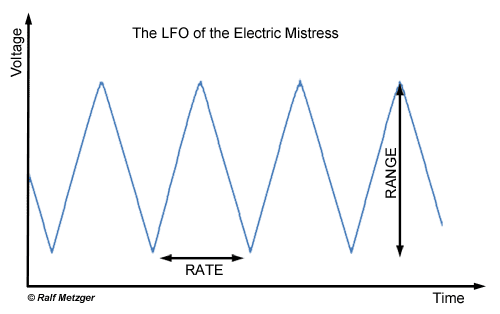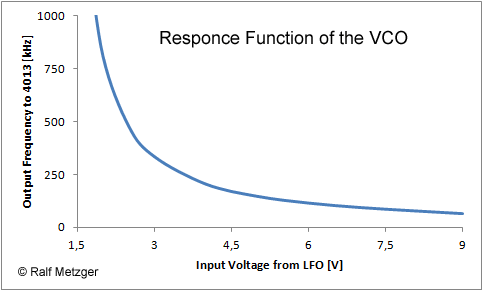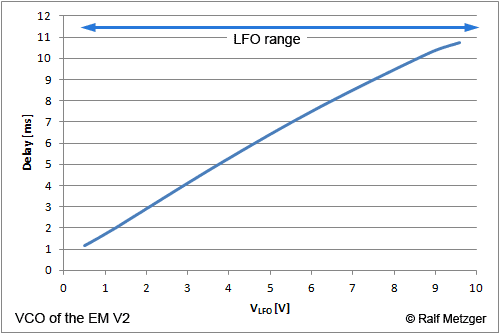| Ralf Metzger | Home | Palm-Software | DIY Hifi | Modellbau | Urlaubsbilder |
| Stompboxes | Home -> Stompboxes -> Mistress |
| How it works... | ||
Back to the main pageContent:
FlangingFlanging is a modulation effect based on swept comb filtering. It was first created in the 1940s* by using two tape recorders. The tape recorders played the identical recording but one was slightly altered in speed by slowing down one reel. Therefore the engineer (e.g. Phil Spector) put one finger on the flange (or rim) of the reel – thus the name flanging. In the 1970s dedicated flanging machines came up but were limited to studios due to their size. Artist who published songs at that time using flanging are e.g. Queen, David Bowie, The Rolling Stones, ELO, The Eagles. The first Flanger using anlogue delay and no tape probably was the Eventide FL201 in 1975. *) It is not shure when is first had been created intentionally. Some claim it had been Les Paul in 1945 Electro-Harmonix recognized the need of guitarists to be able to produce flanging live on stage and David Cockerell developed a such device using an analogue delay. Being a genius synthesizer inventor helped him a lot as the major component which had to be developed was the LFO, also a major component in synthesizers at that time. Basic Principle
Similar to the first tape flanging machines the Electric Mistress also uses two identical signals, one being time delayed. But let’s just travel with the signal through the device. I use the Electric Mistress V2 for explanation (see schematic below). The input signal passes from the guitar by the input socket to a buffer. A buffer is an operational amplifier with gain of 1. It’s easy to recognize in schematics as op-amp with its output directly connected to the inverting input. Gain of 1 means the volume of the output signal is identical to the volume of the input signal. The sense of the buffer is not to amplify the signal but to do impedance transformation. In simple terms spoken its job is to decouple the effects pedal from the guitar and to avoid that anything happening in the effects pedal may influence the guitar’s sound. Later versions don’t use a buffer with gain 1 but a slight amplification to avoid the volume drop the vintage versions have. After the buffer the signal passes through a high pass filter to reduce the low frequencies and avoid aliasing effects by the BBD (don’t worry, they will be restored later) and enter the gain stage. The gain stage is used to boost the volume of the signal to compensate the losses of splitting and filtering and to improve the signal to noise ratio. Now we reach the crossroads where a part of the signal passes the feedback trimmer and the COLOR pot and is feed back to the input of the gain stage. The function of the feedback is to intensify the effect by increasing the comb filter effect. Finally the dry signal and the delayed signal are mixed together and filtered to regain a linear frequency response in the audible range. The resulting signal leaves the device by the On/Bypass footswitch and the output socket. The following sketch illustrates how comb filtering is achieved by mixing a dry and delayed signal. The physical principle is interference. Dashed red is the dry signal, dotted green is the delayed signal and blue is the resulting sum. Every delay time affects a different frequency. That’s why different delay times will create different ‘sounds’.
Using a constant delay time for the delayed signal already generates an effect (that’s what you hear when you run the Mistress in Filter Matrix mode), but the fun starts when the delay time is swept. The swept delay time is commanded by the LFO which can be set by the RATE and RANGE pot. A detailed description of the LFO follows below. To operate the BBD it needs a clock signal. The clock also determines the delay time. To convert the LFO output voltage to a clock with according high frequencies a VCO is used (see below).
And here is where we find the according parts on the V2: Finally we have the voltage regulation. Its job is simply to regulate the 18 V supply to 12 V. A regulation is needed as the supply voltage will vary when using batteries and also DC adapter may vary. To achieve the specified delay times the LFO and VCO need an exact voltage, in our case 12.0 V (but it will also work from 12.0 to 13.5 V with slightly shifted delay times). The voltage regulation is a typical standard op-amp regulator. We have a reference voltage from a 6.8 V Zener diode, an op-amp and a transistor. The voltage divider connected to pin 3 of the op-amp defines the voltage. This voltage is also used to feed the bias trimpod which is also used as a voltage divider. The bias voltage is needed because our signal is alternating currency (AC) and we only have positive supply voltage. The negative half wave of the signal could not be processed by the op-amps and the BBD. The bias voltage sets the origin of the AC signal to bias voltage. E.g. a +- 1 V AC voltage set to 6 V bias now ranges from 5 V to 7 V. BBDLFOThe sweep of the Electric Mistress’ delay time is generated by a LFO (low frequency oscillator). How long one sweep cyle takes is set by the RATE pot. The rate of the maximum output voltage to the minimum output voltage is set by the RANGE pot.The voltage of the LFO is equal to the delay time (low voltage = short delay | high voltage = long delay). See measurements of the Mistresses LFO. The maximum voltage range out of the LFO is different than the voltage commanded in Filter Matrix mode. Especially the Deluxe Electric Mistress V4 and V5 Reissue has a Filter Matrix range of 1.4 V to 8.5 V whereas the LFO ranges only from 1.0 V to 5.1 V.
The heart of all Mistresses LFOs and VCOs are comparators. The most important thing with comparators is that you keep the following in mind. If the voltage at the noninverting input is greater than the voltage at the inverting input its output is high (supply voltage), if the voltage at the noninverting input is equal or lower than the voltage at the inverting input its output is low (0 V). The LFO is rather complicated. It consists of two comparators and a Flip-Flop. The Flip-Flop works like a switch commanding if the LFO voltage (VLFO) is de- or increasing. The Flip-Flop inputs CLOCK and DATA are attached to ground so we use only SET and RESET. The outputs are Q and inverse Q. The RESET input pin 4 of the 4013 is equal to 0.6 * VLFO . If the RESET voltage is lower than 6 V it is considered low, if it is higher than 6 V it is considered high. The SET input is fed by pin 13 of the LM339. V+ (pin 11 LM339) is set to a constant voltage of 0.4 V. VLFO is attached to V- (pin 10). If VLFO is smaller than 0.4 SET is set to high by pin 13 of the LM339. If VLFO is greater than 0.4 V SET is set to low. The switching logic in this special application is:
In the above it says Q and Qinv command charge and discharge, but how? Q and Qinv are connected via two different resistors which form a voltage divider. If Q is low and Qinv is high, the voltage to the RATE pot is 9 V. If Q is high and Qinf is low, the voltage to the RATE pot is 3 V. V+ (pin 5 LM399) is set to constant 6 V. If Q is high and V- (pin 4 LM399) is 9 V the output pin 2 is high. The 2.2 uF capacitor will be charged by the 4.7 k resistor. If Q is low and V- is 3 V the output pin 2 is low. The 2.2 uF capacitor will be discharged by the comparator. To explain how the RATE command works we need to concentrate on the 2.2 uF capacitor. One side is attached to VLFO the other side is attached the Q/Qinv charge/discharge command voltage. If VLFO rises, the VLFO charging voltage is the positive potential and Qinv is the negative potential. The smaller the RATE resistor is, the higher the charging current for the transistor is and the faster VLFO rises. If VLFO falls, pin 2 LM399 is the negative potential and Qinv is the positive potential. The smaller the RATE resistor is, the higher the discharging current for the transistor is and the faster VLFO falls. VCOThe VCO (voltage controlled oscillator) is used to generate a signal with a certain frequency dependent on the input voltage. See measurements of the Mistresses VCO.
The LFO voltage sets the reference voltage at pin 7 of the LM399. Pin 8 is set to a constant small voltage. The BC177 serves as constant current source. It gradually charges the 470p capacitor and in consequence the voltage at pin 6 gradually rises. The output pin 1 is high which sets pin 9 via the 1N914 high, too. At the point where the voltage at pin 6 is equal to the LFO voltage the output at pin 1 toggles to low. Pin 9 drops to low which means pin 14 toggles to low. The 470 capacitor is discharged over pin 14 which means pin 6 drops below pin 7 and pin 1 toggles back to high. Pin 9 is set to high which will toggle pin 14 to high. The 470p capacitor gets charged again and the cycle starts again. The higher the LFO voltage is, the longer it takes to charge the capacitor until the comparator toggles. In consequence the higher the LFO voltage is, the lower the VCO frequency is. As the VCO doesn’t generate a strict rectangular signal with equal high and low periods a D-FlipFlop (4013) is used to create a square signal and an inverted square signal with half of the VCO frequency. The Flip Flop is toggeling its output state every time the input at pin 11 is changing from low to high.
|
